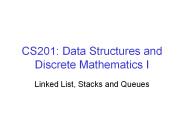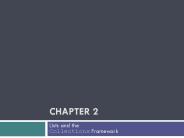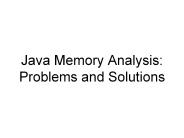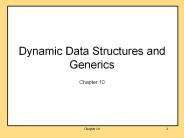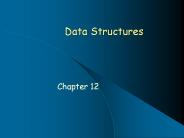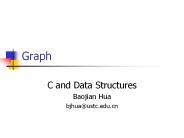Linkedlists PowerPoint PPT Presentations
All Time
Recommended
Jones, William. HashMap. Table consisting of two columns. Column 1 ... Jones, ... Jones, William. 256-41-0920. Madden, Matt. Keys. Values. sorted ...
| PowerPoint PPT presentation | free to view
Linked lists allow for random insertion and deletion ... Stop for a Pause. For the few of you that all that made sense to, go ahead and use it. ...
| PowerPoint PPT presentation | free to view
first. 18. Ruli Manurung (Fasilkom UI) IKI10100I: Data Structures & Algorithms. Week 6 ... contains no data, but serves to ensure that first 'real' node in ...
| PowerPoint PPT presentation | free to view
public LinkedListItr zeroth( ) { } public LinkedListItr first ... LinkedListItr theItr= theList.zeroth( ); int i; printList( theList ); for( i = 0; i 10; i ) ...
| PowerPoint PPT presentation | free to download
Title: PowerPoint Presentation Last modified by: BenQ Created Date: 1/1/1601 12:00:00 AM Document presentation format ...
| PowerPoint PPT presentation | free to download
CS201: Data Structures and Discrete Mathematics I Linked List, Stacks and Queues Data Structure A construct that can be defined within a programming language to store ...
| PowerPoint PPT presentation | free to download
12/29/09. 1. List, Stack, Queue. 12/29/09. 2. List. It is about putting ... What can we do with a list. Find find ... Adam Drozdek (he has a book on data ...
| PowerPoint PPT presentation | free to download
Deletion from or insertion into the middle of the array is costly must shift ... In a linked list, each data object is embedded in a node. ...
| PowerPoint PPT presentation | free to view
Robotics. Bioinformatics. Astrophysics. Medical Imaging. Telecommunications ... Algorithms taking more than this amount of time may exist, but won't help us. ...
| PowerPoint PPT presentation | free to download
Ruli Manurung & Ade Azurat. Fasilkom UI - IKI20100. IKI 20100: Struktur Data & Algoritma ... insert next, prepend - O(1)? delete next, delete first - O(1)? find - O(n) ...
| PowerPoint PPT presentation | free to view
CSE 503 FRI 12/15/2006. 08:00 AM - 11:00 AM, NSC 205. Quiz on Friday. Dec 1 ... Pink Floyd. Pink Floyd. 3. 1. 2. 3. 4. 5. AC / DC. AC / DC. 1. 0. index. Two lists: ...
| PowerPoint PPT presentation | free to view
Chapter 33 Slides. Exposure Java. Linked List I. Chapter XXXIII Topics. Chapter ... Java's ArrayList class allows dynamic resizing during program execution. ...
| PowerPoint PPT presentation | free to view
... 91.404 review part of 91.503 midterm exam, fall 2002, spring 2003, fall 2003 ... To break the lower bound and obtain linear time, forego direct value comparisons ...
| PowerPoint PPT presentation | free to download
Findmin findmax ??????. ????????????????????? binary search tree. Hash table. ????? key ??? value ... ??????? separate chaining. ???????????????? linked list ...
| PowerPoint PPT presentation | free to download
Even in object-oriented languages like Java! You are expected to master the material on data ... Sample idiom for accessing objects via an Iterator i: ...
| PowerPoint PPT presentation | free to view
... array that contains the current objects 'drifts' towards the end of the array, ... (drifting towards back) A circular array implementation of queues (cont'd) ...
| PowerPoint PPT presentation | free to download
Problem: store and retrieving an item using its key (for example, ID number, name) ... Applications: symbol table. on-line spelling checker ...
| PowerPoint PPT presentation | free to download
Chapter 11: Collection of objects In actual programs, always there is need to create and manipulate objects Number of objects is not known at compile time
| PowerPoint PPT presentation | free to download
example: simple hash method with 'baab' and 'abba' There are several ways to handle collisions ... BankAccount a1 = new BankAccount('abba', 100.00) ...
| PowerPoint PPT presentation | free to view
Exploring the Java Collections Framework SOFTENG 251 Object Oriented Software Construction Preamble Tutorial? Review of Generics More on Collections Lists, Sets ...
| PowerPoint PPT presentation | free to view
FOR MORE CLASSES VISIT www.ecet370helps.com ECET 370 Week 1 Lab 1 ECET 370 Week 2 Lab 2 ECET 370 Week 3 Lab 3 Linked Lists ECET 370 Week 4 Lab 4 Complexity of Computational Problems ECET 370 Week 5 Lab 5 Search Algorithms and Techniques ECET 370 Week 7 Lab 7 Binary Trees
| PowerPoint PPT presentation | free to download
Discuss what a hash method does. translates a string key into an integer ... key could be your SID, your telephone number, social security number, account number, ...
| PowerPoint PPT presentation | free to view
FOR MORE CLASSES VISIT www.ecet370helps.com ECET 370 Week 1 Lab 1 ECET 370 Week 2 Lab 2 ECET 370 Week 3 Lab 3 Linked Lists ECET 370 Week 4 Lab 4 Complexity of Computational Problems ECET 370 Week 5 Lab 5 Search Algorithms and Techniques ECET 370 Week 7 Lab 7 Binary Trees
| PowerPoint PPT presentation | free to download
(c) 2002-2003 University of Washington. 16-2. Review: List Implementations ... ArrayList approach: use an array with extra space internally. ArrayList efficiency ...
| PowerPoint PPT presentation | free to download
Title: Inheritance and Class Hierarchies Author: Eliot Moss and Philip King Last modified by: CIS Dept Created Date: 6/18/2004 7:15:49 PM Document presentation format
| PowerPoint PPT presentation | free to download
For more course tutorials visit uophelp.com is now newtonhelp.com www.newtonhelp.com ECET 370 Week 1 Lab 1 ECET 370 Week 2 Lab 2 ECET 370 Week 3 Lab 3 Linked Lists ECET 370 Week 4 Lab 4 Complexity of Computational Problems ECET 370 Week 5 Lab 5 Search Algorithms and Techniques
| PowerPoint PPT presentation | free to download
For more course tutorials visit www.tutorialrank.com General Instructions Exercises 1, 2, 4, and 5 use the programs in DocSharinglabeled “User-defined classes." Exercises 7 and 8 use the programs in DocSharinglabeled “Using interfaces." Exercise 1: Review of classes Create a project using the classes in the DocSharing area labeled “User-defined classes." Compile it, run it, and review the code that is given carefully. Exercise 2: User-defined methods
| PowerPoint PPT presentation | free to download
For more course tutorials visit www.newtonhelp.com ECET 370 Week 1 Lab 1 ECET 370 Week 2 Lab 2 ECET 370 Week 3 Lab 3 Linked Lists ECET 370 Week 4 Lab 4 Complexity of Computational Problems ECET 370 Week 5 Lab 5 Search Algorithms and Techniques ECET 370 Week 7 Lab 7 Binary Trees
| PowerPoint PPT presentation | free to download
For more classes visit www.snaptutorial.com ECET 370 Week 1 Lab 1 ECET 370 Week 2 Lab 2 ECET 370 Week 3 Lab 3 Linked Lists ECET 370 Week 4 Lab 4 Complexity of Computational Problems ECET 370 Week 5 Lab 5 Search Algorithms and Techniques ECET 370 Week 7 Lab 7 Binary Trees
| PowerPoint PPT presentation | free to download
For more course tutorials visit uophelp.com is now newtonhelp.com www.newtonhelp.com ECET 370 Week 1 Lab 1 ECET 370 Week 2 Lab 2 ECET 370 Week 3 Lab 3 Linked Lists ECET 370 Week 4 Lab 4 Complexity of Computational Problems
| PowerPoint PPT presentation | free to download
Title: PowerPoint Author: 1 Last modified by: mdf Created Date: 8/26/2002 10:37:45 AM Document presentation format: Company
| PowerPoint PPT presentation | free to view
Chapter 7 Linked Lists
| PowerPoint PPT presentation | free to download
An Introduction to Data Structures Advanced Programming ICOM 4015 Lecture 17 Reading: Java Concepts Chapter 20
| PowerPoint PPT presentation | free to download
Dynamic memory allocation Recall memory space for method variables parameters and local variables is allocated when the method is invoked, ...
| PowerPoint PPT presentation | free to view
We present numerous common Java application memory problems (anti-patterns), explain how to diagnose them, and propose standard solutions. We then show how several of these anti-patterns were discovered and fixed in two real-life big Java applications.
| PowerPoint PPT presentation | free to download
Title: CS 195 Course Outline & Introduction to Java Author: nwang Last modified by: nwang Created Date: 5/5/2000 9:02:18 PM Document presentation format
| PowerPoint PPT presentation | free to view
Dynamic Data Structures and Generics Chapter 10
| PowerPoint PPT presentation | free to download
The most important thing for good preparation is the appropriate and suitable choice of study material. Our experts have done an endeavor to help IT candidates providing a fully valid and authentic study guide.
| PowerPoint PPT presentation | free to download
Data Structures Chapter 12 Chapter Contents Chapter Objectives 12.1 Introductory Example: Counting Internet Addresses 12.2 The ArrayList and LinkedList Classes 12.3 ...
| PowerPoint PPT presentation | free to download
6.0 Fundamental classes
- This template is used for a creating courseware o a training presentation.
This template is used for a creating courseware o a training presentation.
| PowerPoint PPT presentation | free to view
Title: 1 Author: lik2 Last modified by: Ki-Joune Li Created Date: 1/12/2004 8:00:17 AM Document presentation format: (4:3)
| PowerPoint PPT presentation | free to view
Graph C and Data Structures Baojian Hua bjhua@ustc.edu.cn What s a Graph? Graph: a group of vertices connected by edges Why Study Graphs? Interesting & broadly used ...
| PowerPoint PPT presentation | free to download
Introduction Poo
| PowerPoint PPT presentation | free to download
General Instructions Exercises 1, 2, 4, and 5 use the programs in DocSharinglabeled “User-defined classes." Exercises 7 and 8 use the programs in DocSharinglabeled “Using interfaces."
| PowerPoint PPT presentation | free to download
Two types of arrays Static array size determined at compile time can t change afterwards Dynamic array (JAVA s type, objects) Size determine at run time
| PowerPoint PPT presentation | free to download
FOR MORE CLASSES VISIT www.ecet370assist.com ECET 370 Week 1 Lab 1 ECET 370 Week 2 Lab 2 ECET 370 Week 3 Lab 3 Linked Lists ECET 370 Week 4 Lab 4 Complexity of Computational Problems ECET 370 Week 5 Lab 5 Search Algorithms and Techniques
| PowerPoint PPT presentation | free to download
FOR MORE CLASSES VISIT www.ecet370assist.com ECET 370 Week 1 Lab 1 ECET 370 Week 2 Lab 2 ECET 370 Week 3 Lab 3 Linked Lists ECET 370 Week 4 Lab 4 Complexity of Computational Problems ECET 370 Week 5 Lab 5 Search Algorithms and Techniques
| PowerPoint PPT presentation | free to download
"For more course tutorials visit www.tutorialrank.com ECET 370 Week 1 Lab 1 ECET 370 Week 2 Lab 2 ECET 370 Week 3 Lab 3 Linked Lists ECET 370 Week 4 Lab 4 Complexity of Computational Problems "
| PowerPoint PPT presentation | free to view
FOR MORE CLASSES VISIT www.ecet370assist.com ECET 370 Week 1 Lab 1 ECET 370 Week 2 Lab 2 ECET 370 Week 3 Lab 3 Linked Lists ECET 370 Week 4 Lab 4 Complexity of Computational Problems ECET 370 Week 5 Lab 5 Search Algorithms and Techniques
| PowerPoint PPT presentation | free to download
Cours 2 Introduction
| PowerPoint PPT presentation | free to download
For more course tutorials visit www.ecet370.com ECET 370 Week 1 Lab 1 ECET 370 Week 2 Lab 2 ECET 370 Week 3 Lab 3 Linked Lists ECET 370 Week 4 Lab 4 Complexity of Computational Problems ECET 370 Week 5 Lab 5 Search Algorithms and Techniques ECET 370 Week 7 Lab 7 Binary Trees
| PowerPoint PPT presentation | free to download
3. Estructuras Lineales Est ticas y Din micas Pilas Colas Listas enlazadas Simples Dobles Estructuras de Datos Operaciones B sicas en Estructuras Lineales ...
| PowerPoint PPT presentation | free to view
FOR MORE CLASSES VISIT www.ecet370assist.com ECET 370 Week 1 Lab 1 ECET 370 Week 2 Lab 2 ECET 370 Week 3 Lab 3 Linked Lists ECET 370 Week 4 Lab 4 Complexity of Computational Problems ECET 370 Week 5 Lab 5 Search Algorithms and Techniques ECET 370 Week 7 Lab 7 Binary Trees
| PowerPoint PPT presentation | free to download
For more course tutorials visit www.tutorialrank.com General Instructions Exercises 1, 2, 4, and 5 use the programs in DocSharinglabeled “User-defined classes." Exercises 7 and 8 use the programs in DocSharinglabeled “Using interfaces." Exercise 1: Review of classes Create a project using the classes in the DocSharing area labeled “User-defined classes." Compile it, run it, and review the code that is given carefully. Exercise 2: User-defined methods The function area of the Triangle class is the
| PowerPoint PPT presentation | free to download
Title: 3. Estructuras Lineales Est ticas y Din micas Author: as Last modified by: Miguel Created Date: 9/7/2005 10:19:41 AM Document presentation format
| PowerPoint PPT presentation | free to download
FOR MORE CLASSES VISIT www.ecet370assist.com ECET 370 Week 1 Lab 1 ECET 370 Week 2 Lab 2 ECET 370 Week 3 Lab 3 Linked Lists ECET 370 Week 4 Lab 4 Complexity of Computational Problems ECET 370 Week 5 Lab 5 Search Algorithms and Techniques ECET 370 Week 7 Lab 7 Binary Trees
| PowerPoint PPT presentation | free to download






